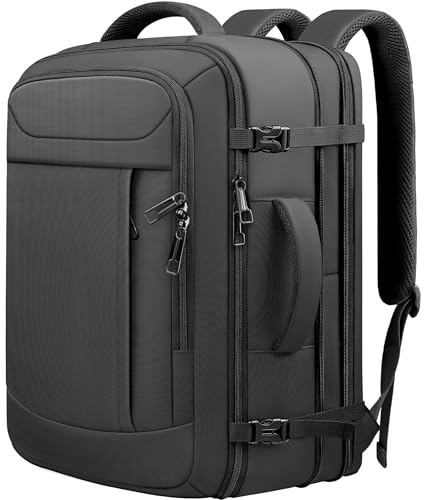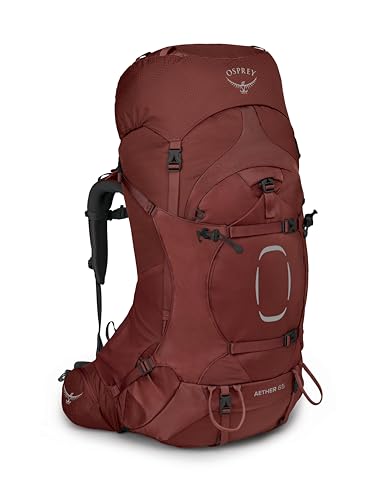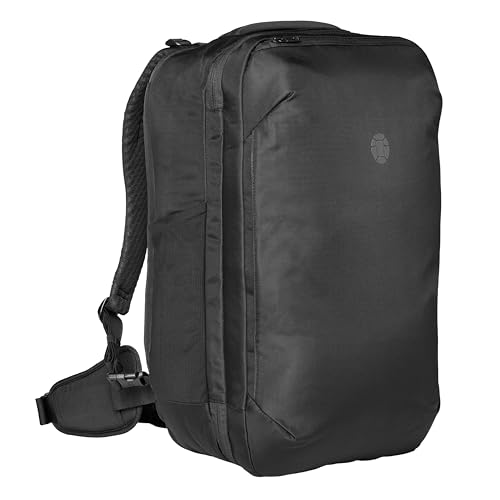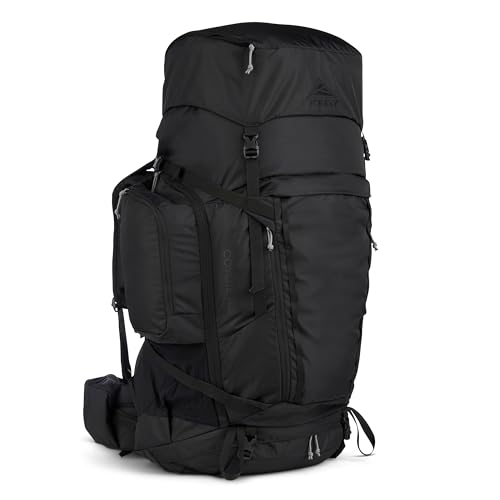If you’ve ever felt shoulder straps cutting into your chest, a hip belt that won’t buckle, or a backpack that looks tiny against your frame, you’re not alone. Finding the best travel backpack for fat guys can be tricky — most packs are built for narrower bodies, leaving the rest of us fighting poor balance, sore shoulders, and constant readjustments mid-walk.
Our top overall pick is the Osprey Farpoint 40L, a carry-on-sized pack that actually fits broader builds. It nails the balance between comfort, support, and smart organization — wide straps, real suspension, and enough structure to carry heavier loads without digging into your back.
In this guide, we’ll compare the best travel backpacks that prioritize fit and comfort, not just features. You’ll get honest mini-reviews (with pros and cons), a practical buyer’s guide, and answers to common fit and sizing questions — all written for real travelers who want gear that simply works.
Let’s get started!
Editor’s Picks: Best Travel Backpack For Fat Guys
- Osprey Farpoint 40L Men’s Travel Backpack – Best Overall In 2025
- Jarwam 55L Extra Large Travel Backpack, Expandable – Best Budget Backpack With Room To Spare
- Osprey Aether 65L Backpacking Backpack – Best for Extended Trips & Heavier Loads
- Tortuga 40L Travel Backpack Lite – Best for Urban & Air Travelers With Broad Shoulders
- Cotopaxi Allpa 35L Travel Pack Del Dia – Best Compact Choice For Light Packers
- Kelty Coyote 60-105 Liter Internal Frame Backpack – Best Adjustable Backpack For Tall & Plus-Size Travelers
- Kelty Redwing 50 – 50 Liter Internal Frame Backpack – Best Hybrid Travel-Trekking Option
How We Chose
Every backpack in this guide was selected through a mix of hands-on research, verified customer feedback, and trusted expert reviews—not marketing hype.
We compared products based on fit, comfort, durability, capacity, adjustability, price, and brand reliability, paying special attention to models that work well for broader or taller travelers.
Each recommendation balances real-world usability with long-term value, so you’ll find both budget-friendly and premium options here. Our goal is simple: to help you choose a backpack that actually fits your body, your travel style, and your budget—with total transparency and no bias.
7 Best Travel Backpacks For Fat Guys Reviewed
Now that you know what makes a backpack actually fit well, let’s look at the top contenders. Each of these picks stands out for comfort, durability, and smart design—whether you’re flying carry-on, road-tripping, or trekking across cities.
Here’s how they stack up in real-world use.
Osprey Farpoint 40L Men’s Travel Backpack – Best Overall
Best for: Frequent flyers or bigger travelers who want true carry-on convenience without sacrificing comfort or structure.

The Osprey Farpoint 40 is the rare travel backpack that actually feels built for a broader body — not just “unisex.” Its secret weapon is the LightWire suspension system, which shifts weight from your shoulders down into a padded hip belt.
For larger-framed travelers, that means you can load it with 8–10 kg of gear and still walk through an airport without those familiar strap bruises.
The shoulder harness is generously padded and adjustable for different torso lengths, while the sternum strap helps the pack sit squarely across wider chests — something many slim-profile travel bags miss.
Inside, the clamshell layout opens like a suitcase, making packing easy even when you’re carrying larger-sized clothing. The fabric feels tough and structured, unlike floppy ultralight models that collapse when half full.
Compared to the Tortuga 40 L Lite, the Farpoint feels more ergonomic for walking long distances but slightly less sleek for city use. It’s a traveler’s pack first, not a fashion piece.
Pros
- Suspension distributes weight evenly, even for bigger torsos.
- Carry-on size yet fits weeklong travel gear.
- Excellent build quality and long-term comfort.
Cons
- Back ventilation could be better in hot climates.
- Minimal quick-access pockets for gadgets.
Jarwam 55L Extra Large Travel Backpack, Expandable – Best Budget Backpack With Room To Spare
Best for: Budget-conscious travelers who want real packing volume and don’t mind a little extra bulk or weight.

If you’re a bigger traveler who tends to pack more clothes or bulkier layers, the Jarwam 55 L hits a sweet spot between space and affordability. It looks like a tech backpack but behaves like soft luggage — the clamshell design unzips completely, letting you lay it flat on a bed or airport floor just like a suitcase. That’s a huge plus when you’re dealing with larger-sized clothes that don’t roll neatly.
The shoulder straps are wide and decently padded for the price, and the adjustable chest strap helps stabilize the load on broader torsos. It’s not built with a full suspension frame like an Osprey, but for a sub-$100 bag, the structure holds surprisingly well.
The expandable section adds an extra inch of depth — handy when you buy souvenirs or overpack before the flight home.
In real use, it feels more like a practical week-to-ten-day pack than a long-haul trekking bag. The outer USB pass-through is convenient for charging on the go, though it doesn’t include a power bank.
Compared with premium models like the Tortuga Lite 40 L, the Jarwam is heavier and less refined, but it wins big on raw capacity and price.
Pros
- Massive expandable space for bulkier packing.
- Lots of organization without overcomplication.
- Excellent value for occasional or budget travelers.
Cons
- Shoulder straps and zippers feel mid-tier under heavy loads.
- No internal frame, so the weight sits squarely on the shoulders.
Osprey Aether 65L Backpacking Backpack – Best For Extended Trips & Heavier Loads
Best for: Plus-size or broad-shouldered travelers planning long, gear-heavy adventures where comfort and stability matter more than weight savings.

If the Farpoint 40 is Osprey’s carry-on star, the Aether 65 is its heavyweight brother — built for serious travelers, trekkers, and anyone with a broad build who carries everything but the kitchen sink. This isn’t just a big bag; it’s a fully adjustable suspension system that molds to your frame.
The “Fit-on-the-Fly” hip belt and shoulder straps slide and contour to match your torso length and waist size, which is a lifesaver for larger travelers who find most packs too short or too tight.
The aluminum frame transfers the load efficiently from your shoulders to your hips, so even when it’s packed with 20+ kg, it doesn’t sag or bite into your back. The ventilated AirScape back panel adds some airflow — not a miracle in hot weather, but better than most 60L+ packs.
Organization is classic Osprey: top-lid storage, sleeping-bag compartment, hydration sleeve, and side access so you don’t have to dig through everything to reach your jacket.
Compared to the Kelty Coyote 60–105 L, the Aether feels more premium and fine-tuned in adjustment, though it’s heavier and pricier. It’s designed for travelers who care about fit precision and comfort above all else.
Pros
- Highly adjustable harness ideal for larger frames.
- Exceptional weight transfer for heavy loads.
- Rugged, expedition-grade materials.
Cons
- Heavy even when empty.
- Overkill for casual or short trips.
Tortuga 40L Travel Backpack Lite – Best For Urban & Air Travelers With Broad Shoulders
Best for: Urban travelers or frequent flyers who want one stylish, comfortable backpack that won’t punish their shoulders during long hauls.

If you like the idea of the Osprey Farpoint 40 but wish it looked a bit more city-smart, the Tortuga Lite 40 nails that crossover. It’s built for people who live out of one bag — digital nomads, weekend travelers, or anyone who hates checking luggage — but it’s also surprisingly comfortable for bigger travelers who want something structured without looking like they’re headed to Everest Base Camp.
The Cordura nylon shell feels premium: tough enough to survive luggage conveyors, yet clean enough to blend into an airport lounge. Inside, the layout opens like a suitcase, giving you clear access to all your clothes (and less swearing at zippers).
The padding is thicker than most urban packs, and Tortuga added real load lifters — a feature missing from many “fashion travel” bags. Those small straps make a big difference in weight balance for broader shoulders.
It’s not as adjustable as the Farpoint or as heavy-duty as the Aether 65, but it hits that sweet spot for everyday travel. The “Lite” version shaves weight by removing some bulkier padding, which most casual users won’t miss unless they’re hauling it for hours.
Pros
- Smart, durable design with premium materials.
- Comfortable carry even for larger builds.
- Perfect size for one-bag international travel.
Cons
- Less torso adjustability than Osprey models.
- Minimal waist padding for heavier loads.
Cotopaxi Allpa 35L Travel Pack Del Dia – Best Compact Choice For Light Packers
Best for: Travelers who pack light, value design as much as function, and want a durable carry-on that stands out without screaming “hiking pack.”

The Cotopaxi Allpa 35L Del Día is the backpack equivalent of a confident extrovert—colorful, organized, and surprisingly well-engineered under the fun. The body uses a TPU-coated 1000D polyester shell, which is water-resistant and nearly scuff-proof, giving it that rubberized toughness you can drag through a bus station or shove into an overhead bin.
Inside, Cotopaxi’s clamshell layout opens flat, revealing mesh-zip compartments that keep clothes, electronics, and toiletries from merging into one chaotic lump—especially handy if your clothes run a bit bulkier.
Even though it’s smaller than the Tortuga Lite 40, the Allpa carries weight comfortably thanks to wide shoulder straps and a lightly padded hip belt that prevents bounce on longer walks. The back panel’s EVA foam helps cushion the load, though larger travelers might wish the torso length were a bit longer.
Still, for short trips or those who prefer packing light, it’s one of the most thoughtfully designed bags on the market.
And then there’s the look—every Del Día edition is one-of-a-kind, stitched from repurposed fabric offcuts. It’s a function with personality.
Pros
- Rugged, water-resistant shell with unique eco design.
- Intuitive organization for efficient packing.
- Comfortable for moderate loads and short hauls.
Cons
- Limited adjustability for tall or broad backs.
- Smaller capacity than 40 L+ competitors.
Kelty Coyote 60-105 Liter Internal Frame Backpack – Best Adjustable Backpack For Tall & Plus-Size Travelers
Best for: Big or tall travelers who need to carry serious gear — whether that’s for extended backpacking, camping, or long-term travel.

The Kelty Coyote 60–105 L is the kind of backpack you buy when you need to carry half your life — and you actually want it to feel comfortable doing it. Designed with Kelty’s FIT-Pro suspension system, it allows real torso adjustment, meaning both tall and broad travelers can fine-tune where the load sits on their back.
That flexibility is huge if you’ve ever tried on a “one-size” pack that rode halfway up your neck.
The internal aluminum frame keeps the structure solid even when fully loaded, while the HDPE frame sheet spreads the pressure evenly across your shoulders and hips. The hip belt is padded and long enough for larger waists — something Kelty rarely gets enough credit for.
Organization is straightforward but generous: top-loading access with a side zipper entry, front stash pockets, and big mesh bottle holders.
Compared with the Osprey Aether 65, the Coyote feels slightly less refined but offers more raw capacity at a friendlier price. The trade-off? A little extra bulk and fewer luxury touches. Still, for the money, it’s one of the most body-inclusive heavy haulers out there.
Pros
- Adjustable torso and belt fit a wide range of body types.
- Excellent stability and load transfer for large capacities.
- Built tough for multi-day travel or trekking.
Cons
- Heavier and bulkier than mid-size packs.
- Less ventilation in warm climates.
Kelty Redwing 50 – 50 Liter Internal Frame Backpack – Best Hybrid Travel-Trekking Option
Best for: Bigger travelers who want one do-it-all backpack — capable of international travel, weekend trips, or light trekking — without the bulk of an expedition pack.

The Kelty Redwing 50 is one of those rare packs that works just as well on a flight as it does on a trail. It’s built for travelers and hikers who want one reliable backpack to do everything — and it happens to be a great fit for larger or taller users thanks to its adjustable suspension.
The FIT-Pro system lets you shift the shoulder harness up or down to match your torso length, a lifesaver for anyone tired of packs that ride up too high or pull backward.
The frame is semi-rigid with a single aluminum stay, giving you enough structure for heavier loads without turning the pack into a stiff box. The hip belt offers decent padding and reach, comfortably accommodating waists up to around 50 inches.
The hybrid U-zip opening lets you load it from the top or lay it flat like a suitcase — an underrated feature when you’re living out of your bag for weeks at a time.
Compared with its bigger sibling, the Kelty Coyote 60, the Redwing is lighter, simpler, and far easier to travel with. It’s that middle ground between technical and practical — the kind of pack you actually grab for a weekend trip, a work retreat, or even a camping night.
Pros
- Adjustable torso and hip belt suit big or tall travelers.
- Dual-access design simplifies packing and retrieval.
- Lightweight yet sturdy for its size.
Cons
- Limited ventilation on long treks.
- Padding feels basic compared to premium Osprey models.
How to Choose the Right Travel Backpack (For Bigger Bodies And Smarter Travel)
Before we wrap up, let’s zoom out for a second. Finding the right travel backpack isn’t just about liters or logos—it’s about fit, comfort, and smart design that actually works for your body. Here’s a quick guide to help you pick one that feels made for you.
Who This Guide Is For
This guide is for anyone who’s ever tried on a backpack that looked great online but felt like a medieval torture device in real life. If you’ve got a broader chest, a longer torso, or simply carry more gear than most, you already know that “one size fits all” usually means “fits almost no one well.”
It’s also for travelers who care about comfort, balance, and long-term usability — not just looks. Maybe you’re a weekend traveler, a digital nomad, or a full-time adventurer who wants a backpack that actually works with your body instead of against it.
If that sounds like you, you’re in the right place.
Why Fit Matters (And Why Most Backpacks Miss The Mark)
Fit is everything. When a pack doesn’t match your body, every mile feels longer and every airport terminal feels steeper.
For larger or taller travelers, the biggest offenders are narrow shoulder straps, short torso lengths, and hip belts that don’t buckle comfortably. These design shortcuts put more weight on your shoulders and less on your hips — exactly the opposite of what you want.
A well-designed pack shifts most of the load to your hips, where your body can handle it more efficiently. Systems like Osprey’s Fit-on-the-Fly and Kelty’s FIT-Pro suspension are great examples: they let you slide the harness or belt to match your torso height and waist size, keeping the pack stable instead of pulling backward.
If you’re mostly city-hopping or commuting, consider models with hidden zippers and locking systems — the kind covered in our Best Anti-Theft Backpack for Travel guide. They protect your gear while keeping comfort first.
Capacity and Size: How Big Is Big Enough?
Before buying, think about how much you actually pack. Backpack capacity is measured in liters (L), and your ideal range depends on trip length and personal packing style.
- 30–40 L: Perfect for short trips, carry-on travel, and minimalists. This is the sweet spot for most weekend travelers — check out our best backpack for weekend trips, for example.
- 45–55 L: The “one-bag travel” zone. Big enough for a week or more, with room for bulkier clothes.
- 60 L +: Ideal for long-term travel or people who need to haul extra gear. Packs like the Osprey Aether 65 L or Kelty Coyote 60 L work best here.
The trick is not to confuse volume with comfort. A 65 L pack with a good suspension can feel lighter than a 40 L pack with bad weight distribution.
Comfort Features That Actually Matter
Every marketing page says “ergonomic design,” but here’s what actually makes a difference:
- Adjustable torso length: Let taller users fine-tune how high or low the pack sits. If you’re 5′11″ + or broad-shouldered, this is non-negotiable.
- Wide, padded shoulder straps: Spread pressure evenly instead of cutting into your arms.
- Ventilated back panels: Reduce sweating, especially in humid climates.
- Structured hip belts: Transfer weight from shoulders to hips, easing strain during long walks.
A good suspension system feels like part of your body — it doesn’t bounce, sway, or shift. If you plan to walk miles between terminals or hostels, these details matter far more than extra pockets.
Build Quality And Materials: What’s Worth Paying For
Backpacks live a hard life — stuffed under seats, tossed into taxis, dragged through rain. Look for fabrics rated by denier (D): higher numbers mean thicker threads and better abrasion resistance.
Common materials include:
- 210D–420D nylon: Lightweight and durable, used in Osprey Farpoint 40.
- 600D + polyester or Cordura nylon: Heavier but rugged, like the Tortuga Lite 40.
- TPU or DWR coatings: Add water resistance without needing a rain cover.
Hardware matters too. YKK zippers and bar-tacked seams last years longer than no-name components.
If you prefer brand reliability, The North Face is famous for bombproof construction — explore options in our best North Face backpack for travel. Their packs often balance premium materials with real-world comfort.
Organization And Accessibility
How a backpack opens changes everything. Clamshell designs (like Cotopaxi Allpa or Tortuga Lite) open flat, suitcase-style — great for travelers who pack neatly. Top-loaders (like Kelty Coyote) favor trekkers who carry gear vertically.
For bigger travelers, internal organization helps prevent the “bottomless pit” effect. Look for:
- Separate laptop or tech sleeves.
- Mesh dividers for clothing.
- Quick-access top pockets for wallets or passports.
- Compression straps that keep the load centered.
If you’re commuting or moving through crowded areas, consider hidden compartments or RFID pockets. They add peace of mind.
Weight, Frame Type, And Balance
This is where the nerdy stuff pays off. Internal-frame backpacks use aluminum stays or plastic sheets to hold shape and shift load toward your hips. For heavy packing or long torso lengths, that internal frame is gold.
Frameless or semi-structured packs are lighter and easier to squeeze into bins but rely entirely on your shoulders and core. Great for city trips, not so much for long hikes.
A good rule: keep your total pack weight around 10–15 % of your body weight. That balance point keeps posture natural and prevents back pain. Bigger bodies can often handle a bit more, but the key is load distribution — not brute strength.
Practical Fit Tips For Bigger Travelers
Fit starts with measurement. Here’s how to get it right:
- Measure your torso length — from the top of your shoulders to the point above your hips (iliac crest). Match that range to the brand’s sizing chart.
- Check the hip belt length. It should buckle comfortably with 3–5 inches of overlap.
- Look for contoured shoulder straps that don’t dig into your chest.
- Do a loaded test at home. Fill your pack with 10 kg and walk for 15 minutes. If it tugs or squeaks, something’s off.
Larger users should skip ultralight “one-layer” straps — they save grams but sacrifice comfort. Instead, pick medium-density foam padding and firm lumbar support.
Bonus Considerations
Beyond comfort, think about the travel realities:
- Airline carry-on limits: Most allow 22 × 14 × 9 in, which fits 40 L packs like the Osprey Farpoint or Tortuga Lite.
- Weather protection: If your pack lacks TPU coating, grab a rain cover.
- Sustainability: Many brands now use recycled nylon and bluesign®-approved dyes.
- Style and context: Outdoor packs scream “adventure,” while urban packs blend better at conferences or coworking spaces.
If you’re still comparing options — from business travel bags to daypacks — explore the broader Backpacks & Bags hub for curated guides by style and purpose.
Final Thoughts: Find The Backpack That Fits You
Here’s the real takeaway: the best backpack for bigger travelers isn’t necessarily the largest — it’s the one that fits your frame, distributes weight properly, and stays comfortable hour after hour.
Think of your backpack as wearable engineering. A few centimeters of adjustability or an extra inch on a hip belt can be the difference between a pleasant trip and shoulder pain for a week.
If you travel light, a structured 35–40 L pack like the Cotopaxi Allpa 35 or Osprey Farpoint 40 will serve you for years. If you’re hauling heavy loads, go with something like the Osprey Aether 65 or Kelty Coyote 60 L + — both designed to balance serious weight on larger torsos.
And if your travel life spans everything from short getaways to long hauls, mix and match: check out our best backpack for weekend trips for lighter setups, or explore the best North Face backpack for travel for bombproof all-rounders.
The bottom line? Comfort first, brand second. Once you’ve found a backpack that truly fits your body, every journey — from airport gates to mountain trails — feels lighter, simpler, and more your own.
See more backpack reviews here.
Frequently Asked Questions (FAQs)
Are travel backpacks for bigger guys more expensive?
Not always. The price usually depends on the brand and build quality, not your body size. That said, premium models like Osprey or Kelty cost more because they include adjustable harness systems, stronger materials, and better padding — features that directly improve comfort for larger frames.
How do I know if a backpack will fit my body type?
Check the torso length and hip belt range in the product specs. A good fit means the hip belt rests on your hips (not your stomach) and shoulder straps wrap comfortably without digging in. If you can adjust torso height or swap belts, you’re on the right track.
Is a bigger backpack automatically better for larger travelers?
Not necessarily. Bigger packs hold more, but they also add weight. What matters more is balance and structure — a solid internal frame and a hip belt that can actually carry the load. For most travelers, a 40–55 L pack is the sweet spot for comfort and capacity.
How long do good travel backpacks last?
A well-made travel backpack can easily last 8–10 years with proper care. Look for durable nylon (210D or higher), double stitching, and YKK zippers. After trips, clean dust or sweat residue, and store it dry to prevent mildew — that’s the simplest way to extend its life.
What’s the best way to clean and maintain my backpack?
Avoid throwing it in the washing machine. Instead, use mild soap, a soft brush, and lukewarm water to clean the outer fabric. Rinse gently, air-dry completely, and never hang it in direct sunlight — UV light weakens nylon fibers over time.
Are anti-theft backpacks worth it for travel?
Yes, especially if you’re moving through crowded cities or public transport. Anti-theft features like hidden zippers, lockable pulls, and RFID pockets add peace of mind without much extra weight.
